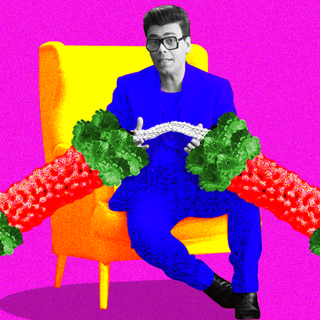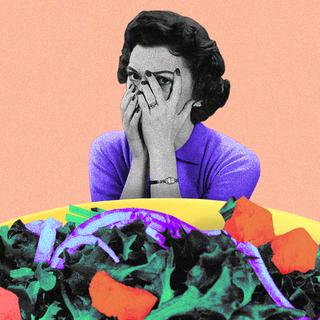
Can We Move On: From the Trope of the Woman Who Must Transform Her Looks to Win a Man’s Love
Movies relying on the trope also portray women who don’t dress a certain way, or seem conventionally alluring, as ‘undateable.

In Can We Move On, we revisit old tropes and question whether they have any remaining cultural relevance.
I was exposed to Kuch Kuch Hota Hai at an age when I was so impressionable; the rom-com left a lasting impression on my mind. My takeaway from the classic: if I don’t adopt a soft, feminine aesthetic for my wardrobe, the man of my dreams will ditch me for someone who does, and might only return if I fundamentally change myself (read: undergo a makeover) to fit his idea of a “woman worth loving.” Given that the movie was released in 1998, more than two decades ago, some would argue that the trope is a relic of the past — one that just hasn’t aged well.
But the thing is, having made its way into the present, the trope is not a throwback to another era. While 2013’s Yeh Jawaani Hai Deewani is one of the more recent appearances of the trope in a superhit movie, 2004’s Main Hoon Na was, perhaps, one of the first times it resurfaced in a classic in the 2000s.
While Kuch Kuch Hota Hai introduced the trope to my generation, Main Hoon Na reinforced the idea in many women my age that looking good in a conventional way is a must in order for men to find us attractive. It functioned, or much rather functions, as gospel truth in most rom-coms. Needless to say, the trope does much harm; it propagates toxic ideas about desirability, unhealthily lowering our expectations from a partner, complicating our relationships with our natural bodies, and restricting our self-expression.
In the 2004 movie, we see the character of Sanjana, played by Amrita Rao, undergo a makeover on the advice of Shah Rukh Khan’s character, and the guidance of Sushmita Sen’s. The reason behind her transformation from a “boyish” aesthetic to a “girly” one — complete with apink suit and silver jhumkas — was to get Lucky, her love interest played by Zayed Khan, to find her desirable. It works, of course, as his jaw drops open and everyone breaks into Tumse Milke Dil Ka Hai Jo Haal… (a song-and-dance sequence) to show him falling head-over-heels in love with her.
“Bollywood clearly states that nature, character, and the heart of the person [don’t] matter. Just change your wardrobe, get some girlish style, imbibe some grace, and you are ready to get the man of your dreams,” states an article.
Related on The Swaddle:
Can We Move On: From the Trope of the Woman Who Perfectly Balances Sanskaar and Sexinesss
In 2013, Yeh Jawaani Hai Deewani managed to advance the same trope yet again. Naina, played by Deepika Padukone, transformed from a straight-haired spectacled woman with a “nerdy” aesthetic to a wavy-haired, non-spectacled one with a… umm… “hot” aesthetic, for lack of a better descriptor. Turns out, it was her pair of glasses that were stopping Bunny, played by Ranbir Kapoor, from noticing how attractive the conventionally beautiful Padukone was. It’s a bizarre notion to think non-spectacled people are better looking. It may not have made sense, but the reason it was easy to let logic go was that it was using a trope that had, by this point, been drilled deep into our psyche through its repeated iterations in pop culture. It inspired ideas of romance, that we’ve ceased to question — almost as if we think, “yeah, this is how it works.”
Except, it shouldn’t. And that’s precisely why the messaging of this trope is so harmful. Yet, its usage in Bollywood abounds. From 1986’s Naseeb Apna Apna to 2003’s Kal Ho Na Ho to 2010’s Aisha, the trope has endured the test of time. “From introducing the term “chashmish” (spectacled) in the vocabulary of every guy I went to school with, to actually making Naina [played by Priety Zinta] believe that she only looks beautiful without her glasses, this movie made every teenage girl doubt herself — including me,” Akansha Bhatia wrote of Kal Ho Na Ho.
Moreover, the movies also portray women who don’t dress a certain way, or seem conventionally alluring, as unequivocally “undateable.” In fact, it’s something Bollywood manages to do even without the makeover trope. Commenting on 2002’s Mujhse Dosti Karoge, Bhatia says, “Hrithik’s character walks right past Rani Mukherji and assumes Kareena Kapoor is the gorgeous girl he’s been fantasizing [about] a childhood romance with. For once can Bollywood give us a story where they pick the not-so-fancy girl on purpose and not out of compulsion?” added Bhatia.
In 2003’s Ishq Vishk, too, we see Shahid Kapoor’s character, Rajiv, being embarrassed about his friends teasing him with Payal, played by Rao again, until she shows up looking pretty for a college event. However, he does ditch her temporarily for a conventionally better-dressed, “hotter” woman — actually, an unexpectedly realistic depiction of a guy, who chooses to date women based on how they look.
Moreover, movies tend to promote a glorify a Euro-centric ideal. “Before her ‘makeover,’ she doesn’t have pink cheeks which blush like a white woman’s skin might. It’s natural and brown. Apparently, this is all supposed to be a sign that she’s not pretty. So, once she gets the makeover and puts on pink-toned lipgloss and paler eye makeup, she’s suddenly this Paris Hilton-approved picture of femininity,” reads an article from 2020.
Related on The Swaddle:
Can We Move On: From the Trope of the ‘Controlling’ Girlfriend
These movies — representative of the toxic male gaze — not only further a homogenous beauty standard but also promote the idea that women dress up only to seduce men. Perhaps, that’s why men feel entitled to constantly comment on women’s looks — for better or for worse — and offer unsolicited opinions like, “I’d prefer if you did that instead of this.” Well, who asked you, dear sir? The trope can distort a women’s sense of self by manipulating young minds into calculating their worth based on how attractive men might find them — furthering patriarchy’s stronghold on society.
Arguably, the trope of “looking good to be worthy of dating” feeds into a sense of insecurity and undesirability for women. Even when they are in relationships, the idea that their partner might leave them for a more attractive woman, just like Rajiv did, continues to linger and haunt them.
Thankfully, some movies have begun to question the sexism inherent in the trope. In Main Hoon Na, Sanjana not only calls Lucky out for being shallow but is also seen donning clothes from her pre-makeover wardrobe afterward. “While it is still problematic, Sanjana calling out Lucky’s hypocrisy after was an important addition. Sanjana says what we’re all thinking: she became the object of Lucky’s attraction once she changed herself… Through this, her character shined a light on the sexism and unfair gender expectations that start and end with her appearance,” Saumya Kalia wrote in The Swaddle.
It’s another matter that Sanjana still ends up with Lucky to keep up with the “all’s well that ends well” narrative. But in 2010’s Aisha, Shefali, played by Amrita Puri, is valiantly more assertive; rather than pursuing a relationship with the guy she had dressed to impress, she chooses the guy who liked her before her makeover too.
However, Yeh Jawaani Hai Deewani, which was released after both, chose to undo the progress made by Sanjana and Shefali, and instead, fortified the trope.
With women around the world struggling with make-up tax, unrealistic beauty standards, and the resultant low self-esteem, perhaps, it’s time we moved on from this deeply embedded notion of transformation-for-love. The idea we must spend thousands of rupees, if not more (hey, makeovers can be expensive), to let go of our individual sense of style just so we can get our love interest to reciprocate our feelings is misogynistic, untenable, and ridiculous. Maybe we should hark back to Jab We Met’s Geet when she says: “Main apni favorite hoon” (I’m my favorite person) rather than changing ourselves for whose interest in us is no more than skin-deep.
Devrupa Rakshit is an Associate Editor at The Swaddle. She is a lawyer by education, a poet by accident, a painter by shaukh, and autistic by birth. You can find her on Instagram @devruparakshit.
Related


Is This Normal? ‘I Don’t Like to Eat in Front of Other People’
